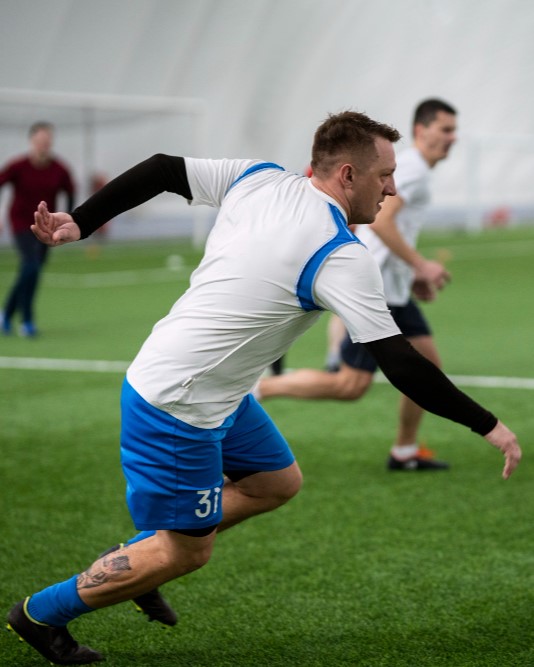
Dr. Praveen Kumar KS stands as a highly skilled sports medicine specialist, bringing a wealth of expertise to the forefront of orthopaedic care. With a distinguished role as the Orthopaedic Surgeon for the Kerala Blasters Football Club during the 2019-2020 season, his commitment to sports medicine is evident. Holding dual positions as Consultant Orthopaedic Surgeon and Sports Medicine Specialist for the FFA Football Academy and RS Sports Academy in Cochin, Dr. Praveen demonstrates a comprehensive approach to musculoskeletal health in the dynamic world of sports. His dedication to providing specialized care underscores his pivotal role in optimizing the athletic performance of individuals under his professional purview.

Achilles tendon rupture occurs when the robust fibrous cord linking..
View Details
The ACL is a crucial knee ligament preventing excessive movement between..
View DetailsInjuries in football can be complex and varied, ranging from common sprains and strains to more serious issues like ACL injuries. The dynamic nature of the sport, with its sudden stops, starts, and physical contact, puts players at risk for a range of injuries. These can affect different parts of the body, including the ankles, knees, and shoulders.
Tennis elbow is a frequently encountered and uncomfortable condition arising from the excessive use of your arm. The repetitive strain associated with activities such as typing, knitting, engaging in golf, exercising, or carrying heavy items can result in inflammation or tears within the tendon connecting your forearm to the elbow joint. This means that if you're experiencing pain in your elbow, it's essential to recognize that it may not solely be attributed to playing tennis. Various everyday actions could be contributing to this discomfort, underscoring the importance of understanding and addressing these factors for effective relief.
If you suspect you have tennis elbow, it's advisable to reach out to an orthopedic expert for guidance and assistance. They can provide a proper diagnosis and recommend suitable treatments to help alleviate the discomfort and support your recovery. Don't hesitate to seek professional advice for the best course of action tailored to your specific situation. Feeling the pain of tennis elbow? Reach out to an orthopedic expert for personalized guidance and relief.

A sports medicine surgeon specializes in the diagnosis, treatment, and prevention of injuries related to physical activity and sports. Their role encompasses various aspects of musculoskeletal health, focusing on athletes and individuals with active lifestyles. Key responsibilities include:
1. Injury Evaluation and Diagnosis:
Conducting thorough assessments to diagnose sports-related injuries, including fractures, ligament tears (like ACL tears), and other musculoskeletal problems.
2. Non-Surgical Treatment:
Providing non-surgical interventions such as physical therapy, medications, and rehabilitation programs to manage and treat injuries without surgical intervention when possible.
3. Surgical Interventions:
Performing surgical procedures when necessary to repair or reconstruct damaged tissues, such as ligaments, tendons, or cartilage. Common surgeries may include arthroscopy for joint issues or ligament reconstruction.
4. Preventive Care:
Advising athletes and active individuals on injury prevention strategies, including proper warm-up techniques, conditioning exercises, and biomechanical assessments.
5. Rehabilitation and Postoperative Care:
Overseeing the rehabilitation process after surgery, guiding patients through exercises and therapies to optimize recovery and restore function.
6. Collaboration with Other Specialists:
Collaborating with physical therapists, nutritionists, and other healthcare professionals to provide comprehensive care for athletes.
7. Concussion Management:
Managing and monitoring concussions and head injuries, ensuring a safe return to sports activities.
8. Performance Enhancement:
Offering guidance on improving athletic performance through biomechanical analysis, strength training, and conditioning programs.
9. Team Physician Role:
Serving as team physicians for sports teams, both amateur and professional, providing immediate care during games and competitions.
10. Education and Research:
Staying updated on the latest advancements in sports medicine, contributing to research, and educating athletes and the community on injury prevention and treatment.
Sports medicine is a specialized field within healthcare that addresses the unique health needs of individuals involved in sports and physical activities. It encompasses a wide range of disciplines, including orthopedics, physiatry, physical therapy, exercise physiology, and nutrition.
Key aspects of sports medicine include:
Injury Prevention: Sports medicine professionals work to prevent injuries by providing guidance on proper training techniques, biomechanics, and equipment use. They may also offer advice on nutrition and hydration.
Treatment of Injuries: When injuries occur, sports medicine practitioners diagnose and treat conditions such as sprains, strains, fractures, and dislocations. They may utilize both surgical and non-surgical interventions.
Rehabilitation: Sports medicine focuses on the rehabilitation of athletes after injuries or surgical procedures. Physical therapists play a crucial role in designing rehabilitation programs to restore function and strength.
Performance Enhancement: Professionals in sports medicine collaborate with athletes to optimize performance. This involves assessing biomechanics, strength, flexibility, and conditioning to enhance overall athletic abilities.
Medical Coverage: Sports events often have medical teams that include sports medicine physicians to provide immediate care for injuries that may occur during competitions.
Concussion Management: Sports medicine specialists are involved in the evaluation and management of concussions, ensuring a safe return to play for athletes.
Exercise Prescription:Sports medicine physicians prescribe exercise programs tailored to individual needs, whether for rehabilitation or performance improvement.
Overall, sports medicine is a comprehensive field that aims to keep athletes healthy, treat injuries effectively, and support their optimal performance through a combination of medical expertise, rehabilitation, and preventive strategies
Common sports injuries can occur due to various factors, including overuse, improper training techniques, or accidents during physical activity. Some prevalent sports injuries include:
Sprains: Injuries to ligaments, which connect bones to each other. Commonly seen in the ankles (ankle sprains) or knees (ACL/MCL sprains).
Strains: Overstretching or tearing of muscles or tendons. Hamstring strains and quadriceps strains are frequent in sports
Contusions: Bruises resulting from direct impact or trauma to the body, often caused by collisions in contact sports.
Fractures: Broken bones, typically from high-impact injuries. Common in contact sports or those with a risk of falls.
Dislocations: Joint displacement, commonly seen in the shoulder and finger joints, often occurring during high-impact activities.
Tendonitis Inflammation of tendons due to repetitive motion or overuse. Common in the Achilles tendon (Achilles tendonitis) or around the knee (patellar tendonitis).
Meniscus Tears: Tears in the cartilage discs (menisci) of the knee, often resulting from twisting or direct impact.
Stress Fractures: Small cracks in bones due to repetitive stress, common in weight-bearing bones like the shin (shin splints).
Concussions Traumatic brain injuries resulting from a blow to the head. Common in contact sports like football and soccer.
Rotator Cuff Injuries: Injuries to the muscles and tendons around the shoulder joint, often due to repetitive overhead motions.
Plantar Fasciitis: Inflammation of the plantar fascia, causing heel pain, often seen in runners and athletes with high-impact activities.
Tennis/Golfer's Elbow: Overuse injuries causing pain around the elbow, common in activities involving repetitive wrist and arm motions.
Groin Pull/Strain: Strain in the muscles of the inner thigh or groin area, often seen in sports requiring sudden direction changes.
Heat-Related Illnesses:Conditions like heat exhaustion or heatstroke due to prolonged physical activity in hot environments.
Proper warm-up, conditioning, and adherence to safety guidelines can help prevent many sports injuries. Prompt and appropriate medical attention, including rest, rehabilitation, and sometimes surgery, is crucial for recovery when injuries occur.
You should consider consulting a sports medicine surgeon under various circumstances, including:
Acute Injuries: For immediate care and evaluation of acute injuries, such as fractures, dislocations, or significant ligament tears (e.g., ACL tears).
Chronic Pain: Persistent or recurrent pain, especially if it interferes with your daily activities or sports performance.
Limited Range of Motion: If you experience difficulty moving a joint or have a noticeable reduction in range of motion.
Swelling and Inflammation: Persistent swelling, inflammation, or joint effusion, especially following an injury or overuse.
Failed Conservative Treatments: When conservative treatments, such as rest, physical therapy, and medications, have not provided sufficient relief.
Recurrent Injuries: If you have a history of recurrent injuries, especially in the same area, indicating a potential underlying issue.
Suspected Tendon or Ligament Injuries: When you suspect injuries to tendons or ligaments, as sports medicine surgeons specialize in managing these structures.
Functional Limitations: When injuries or conditions limit your ability to participate in sports or other physical activities.
Concerns about Surgery If surgical intervention is a potential consideration, a sports medicine surgeon can assess the need and discuss the options.
Preventive Consultation: Athletes or individuals engaged in regular physical activity may seek preventive consultations to assess and address potential risk factors for injuries.
Postoperative Care: If you have undergone surgery for a sports-related injury, a sports medicine surgeon can provide postoperative care and guide rehabilitation.
Concussion Management: If you've experienced a concussion during sports activities, a sports medicine specialist can help manage and monitor your recovery.
In all cases, it's important to prioritize your health and seek professional medical advice if you have concerns about sports-related injuries. A sports medicine surgeon can provide specialized expertise in diagnosing and managing musculoskeletal issues related to sports and physical activity. Early intervention and appropriate care can contribute to optimal recovery and a quicker return to activities.
Preventing sports injuries involves a combination of proper training, conditioning, and safety measures. Here are key strategies to help minimize the risk of sports-related injuries:
Warm-Up and Cool Down: Engage in dynamic warm-up exercises to prepare muscles and joints before activity. Follow with a cool-down to gradually lower heart rate and prevent stiffness.
Proper Technique: Learn and consistently use proper techniques for your sport to reduce the risk of overuse injuries and muscle imbalances.
Gradual Progression: Gradually increase the intensity, duration, and frequency of your activities to allow your body to adapt to the demands.
Cross-Training: Include a variety of exercises and activities to prevent overuse of specific muscles and reduce the risk of repetitive stress injuries.
Strength Training: Incorporate strength training exercises to enhance muscle stability, improve joint support, and prevent injuries.
Flexibility Training: Include regular stretching exercises to maintain flexibility and reduce the risk of muscle strains and tears.
Proper Equipment: Wear appropriate protective gear and equipment, such as helmets, pads, or supportive footwear, depending on the sport.
Footwear: Use properly fitting athletic shoes suitable for your sport to provide adequate support and reduce the risk of foot and ankle injuries.
Hydration: Stay adequately hydrated to support overall body function and prevent issues like heat-related illnesses.
Rest and Recovery: Allow sufficient time for rest and recovery between intense training sessions to prevent overtraining and reduce the risk of injuries.
Nutrition: Maintain a balanced diet to support overall health and provide essential nutrients for muscle and bone health.
Regular Health Check-ups: Undergo regular health check-ups to identify and address any underlying health conditions that might contribute to injury risk.
Listen to Your Body: Pay attention to signs of fatigue, pain, or discomfort. If something doesn't feel right, take the necessary rest and seek medical advice.
Safety Guidelines: Follow established safety guidelines and rules of the sport to minimize the risk of accidents and collisions.
Educational Programs: Participate in educational programs or workshops on injury prevention and sports safety.
By integrating these strategies into your training routine and adopting a proactive approach to your health, you can significantly reduce the likelihood of sports-related injuries and enhance your overall athletic performance.